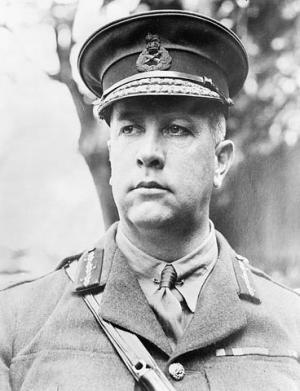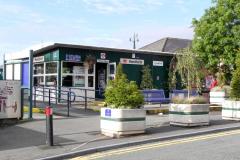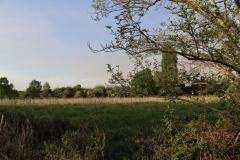
The above remark is attributed to Crown Prince Rupprecht, commander of the 6th German army facing the attacking British in Flanders and events in October were to underline this. Plumer's careful, co-ordinated tactics had brought localized success at Polygon Wood (26th September - 3rd October), but we now embarked on 3 more sustained offensives this month.
On the 4th October we attacked Broodseinde Ridge. This valuable strategic platform was gained, but casualties were heavy. The incline was where the Northumberland Fusiliers seeing a resemblance between the enemy pillboxes facing them and cottages beside a familiar river bestowed on the ridge the immortal name "Tyne Cot".
Already however, there were warning signs. British artillery and infantry could not give sustained support as we moved forward. As ever around Ypres in 1917, the weather decided the fate of the battle.
For example, it took the East Lancs brigade 8 hours to march 4 miles to "leap frog" the lads who had achieved so much in the first assaults. The Australians and New Zealanders suffered horribly. Hindsight suggests Haig should have called a halt after Broodseinde (4th October) before the weather broke, but 5 days later we attacked Poelcappelle (9th October) - a "shambles".
Confused reports from the front led Haig and Plumer to believe the Allies could now make a bid for Passchendaele and the crest 7 miles away. First Passchendaele (12th October) was a disaster, because of the inadequate creeping barrage, largely untouched barbed wire, immediate enemy counter-attacks and above all, appalling weather and ground conditions.
Haig needed fresh troops - the British and Anzacs were exhausted. Haig turned to Lt General Arthur Currie and the 4 divisions of Canadian Corps, famed for the victory at Vimy Ridge. Currie refused to serve under Gough, but respected Plumer. Ever careful and aware of the terrain and supported by 6 British divisions he began a carefully integrated and rehearsed assault on the ridge.
He estimated 16,000 casualties. (Had he been British not a "colonial" he would probably have been dismissed for the virulent verbal attacks on what he saw as the incompetence of most of the generals guiding our attacks.) Second Passchendaele began on 26th October. Would we take it?
Wilmslow and the wider community lost 10 young men in "Flanders Fields" this month.
Second Lt Walter Robert DODGE, Military Medal; 2nd; Hawthorn Lane, Wilmslow; 20th Manchesters, Buttes Wood British Cemetery, Polygon Wood.
Pte John THORLEY; 2nd; Nursery Lane, Wilmslow; 4th Grenadier Guards; Poelcapelle British Cemetery.
Pte John BAILEY; 4th; Handforth; 22nd Manchesters; Hooge Grater Cemetery.
Pte Herbert BARR; 7th; Chelford; Cheshire Regiment; Spoilbank Cemetery.
Pte Charles Anthony SMITH; 11th; Poplar Farm, Moor Lane, Wilmslow; 2nd Lancs Fusiliers; Dozinghem Military Cemetery.
Pte Samuel HULONE; 13th; Fulshaw; 1st/5th West Yorkshires; St John's Lindow churchyard.
Pte Leonard SWINDELLS; 18th; Bollin Walk, Wilmslow; 8th Yorkshires; no known grave.
Gunner Ernest SNAPE; 22nd; New Street, Wilmslow; 12th Battery Royal Field Artillery; Huts Cemetery, Ypres.
Lance Corp James BROUGHTON; 26th; Finney Green; 4/5th Loyal North Lancs; no known grave.
Pte Eric NOPPEN; 26th; Eden Field Farm, Moor Lane, Wilmslow; 2nd/4th Loyal North Lancs, no known grave.
All of the men are remembered locally in churches, on memorials or in graveyards - often in more than one place. Three are commemorated at Tyne Cot.
There was an eleventh casualty this month namely Lance Corp Henry FLETCHER of the 3rd Coldstream Guards. He was actually wounded on the Somme in September 1916, was then discharged and died of his wounds on the 8th October 1917. He had lived at 41 Brook Lane and is buried in St John's Lindow, churchyard.
Away from Flanders, there were memorable events. Mata Hari was shot, aged 41, by a French firing squad for spying for the Germans. The last airship raid on the UK ended as most of the attackers were being shot down. Insurrections began in Petrograd. On the 24th, the pretty scenic town of Caporetto, in the Isonzo Valley fell into German hands - the Italian retreat became a rout. Plumer and many of his troops were soon after diverted from Flanders to help stop their retreat at a time crucial to the war effort on the Western Front.
Photo: Sir Arthur Currie Copyright Library and Archives Canada under the reproduction reference number PA-001370.
Jon Armstrong and Alan Cooper
Wilmslow Historical Society
with a contribution from Michael Scaife









